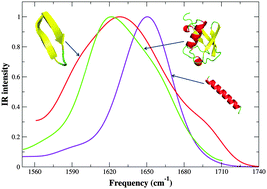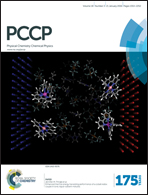Fragment quantum chemical approach to geometry optimization and vibrational spectrum calculation of proteins†
Abstract
Geometry optimization and vibrational spectra (infrared and Raman spectra) calculations of proteins are carried out by a quantum chemical approach using the EE-GMFCC (electrostatically embedded generalized molecular fractionation with conjugate caps) method (J. Phys. Chem. A, 2013, 117, 7149). The first and second derivatives of the EE-GMFCC energy are derived and employed in geometry optimization and vibrational frequency calculations for several test systems, including a polypeptide ((GLY)6), an α-helix (AKA), a β-sheet (Trpzip2) and ubiquitin (76 residues with 1231 atoms). Comparison of the present results with those obtained from full system QM (quantum mechanical) calculations shows that the EE-GMFCC approach can give accurate molecular geometries, vibrational frequencies and vibrational intensities. The EE-GMFCC method is also employed to simulate the amide I vibration of proteins, which has been widely used for the analysis of peptide and protein structures, and the results are in good agreement with the experimental observations.


 Please wait while we load your content...
Please wait while we load your content...